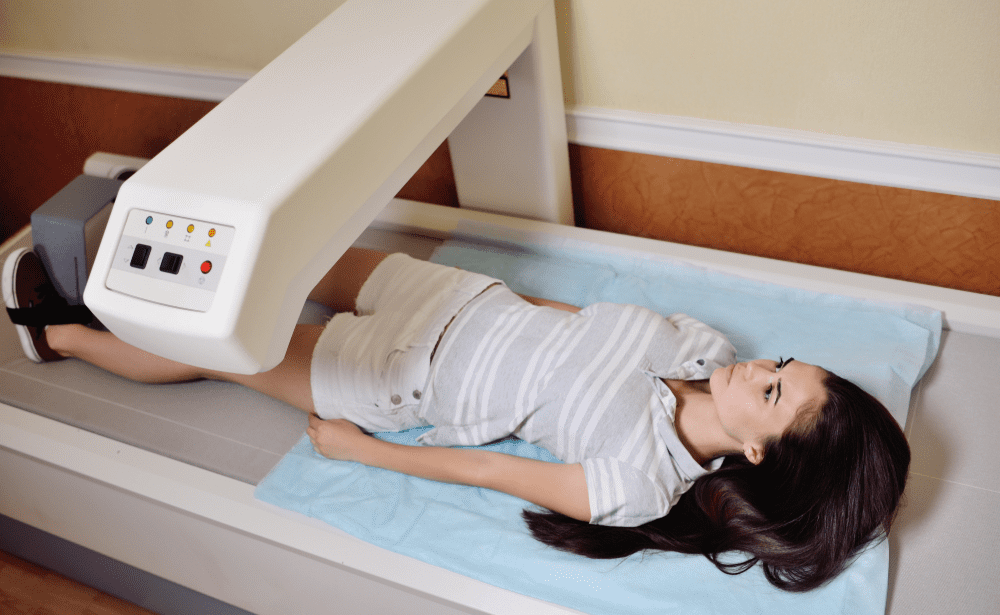Overview
A DEXA (Dual-Energy X-ray Absorptiometry) scan is a specialized imaging test used to assess bone mineral density (BMD). This non-invasive procedure is a crucial tool in diagnosing and monitoring conditions such as osteoporosis, a disease characterized by weak and brittle bones, which increases the risk of fractures. DEXA scans are quick, painless, and provide accurate measurements of bone density in various parts of the body, primarily the hip and spine.
Indications for DEXA Scans
DEXA scans are recommended for a variety of reasons, including:
- Osteoporosis Screening: To assess the risk of fractures in postmenopausal women and older adults.
- Bone Density Monitoring: For patients undergoing treatment for osteoporosis or other conditions affecting bone health.
- Risk Assessment: In individuals with risk factors such as a family history of osteoporosis, prolonged steroid use, or conditions like rheumatoid arthritis.
- Fracture Risk Evaluation: To evaluate bone density in patients who have experienced unexplained fractures or low-trauma fractures.
Diagnostic Procedures
- Pre-scan Assessment:
- A healthcare provider will evaluate the patient’s medical history, risk factors for osteoporosis, and any symptoms related to bone health.
- DEXA Scan Procedure:
- The patient lies on a padded examination table, and a scanning arm passes over the body, emitting low-dose X-rays to measure bone density.
- The procedure typically takes about 10-20 minutes, during which the patient is asked to remain still.
- Post-scan Care:
- No special aftercare is needed, and patients can resume normal activities immediately.
Analyzing DEXA Scan Results
- T-score and Z-score:
- The results of a DEXA scan are typically reported as T-scores and Z-scores:
- T-score: Compares the patient’s bone density to that of a healthy 30-year-old of the same sex. A T-score of -1.0 or above is considered normal, -1.0 to -2.5 indicates osteopenia (low bone mass), and -2.5 or lower indicates osteoporosis.
- Z-score: Compares the patient’s bone density to that of individuals of the same age and sex. A Z-score of -2.0 or lower may suggest that bone density is below the expected range for age.
- The results of a DEXA scan are typically reported as T-scores and Z-scores:
- Clinical Interpretation:
- A healthcare provider will interpret the results in conjunction with the patient’s medical history and risk factors to develop a comprehensive management plan.
Potential Benefits of DEXA Scans
- Early Detection: DEXA scans enable the early detection of low bone density, allowing for timely intervention and prevention of fractures.
- Monitoring Treatment: Regular DEXA scans can help assess the effectiveness of osteoporosis treatments and adjust management strategies as needed.
- Personalized Care: The results facilitate individualized treatment plans based on the patient’s specific bone health needs.
Possible Risks and Side Effects
- Radiation Exposure: DEXA scans involve minimal exposure to radiation, which is considered safe and significantly lower than other imaging tests.
- Discomfort: Although the scan is painless, some patients may feel discomfort while lying still for the duration of the procedure.
Final Results
With appropriate use, DEXA scans can lead to:
- Informed Decision-Making: Accurate assessment of bone density helps healthcare providers make informed decisions regarding treatment options and lifestyle modifications.
- Enhanced Bone Health: Early detection and management of low bone density can lead to improved bone health and a reduced risk of fractures.
- Patient Empowerment: Understanding bone health enables patients to take proactive steps toward maintaining and improving their bone density through lifestyle changes and medical interventions.

